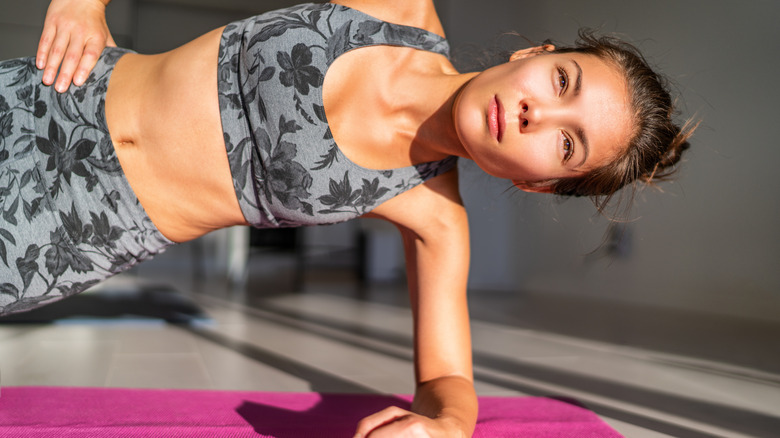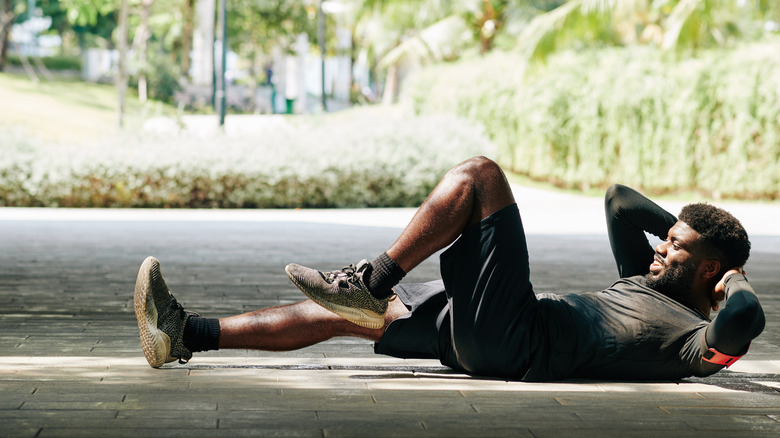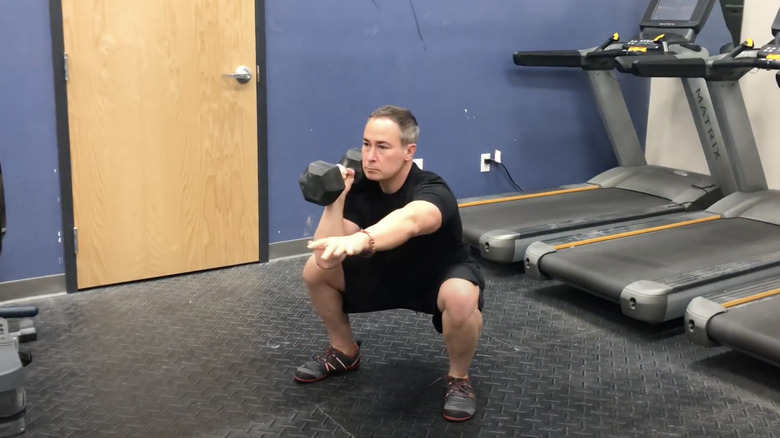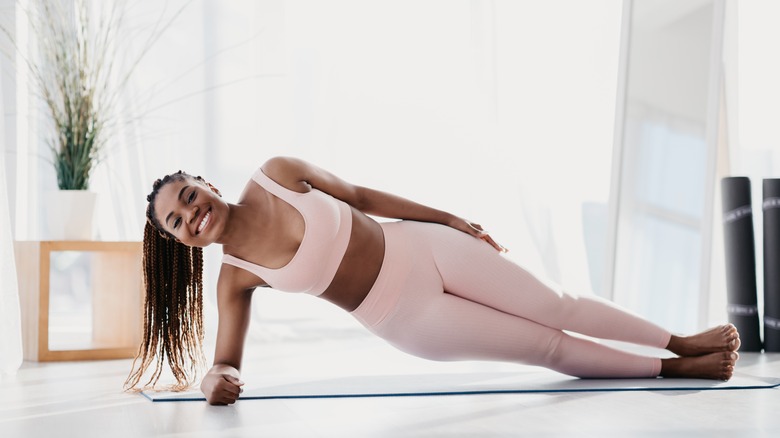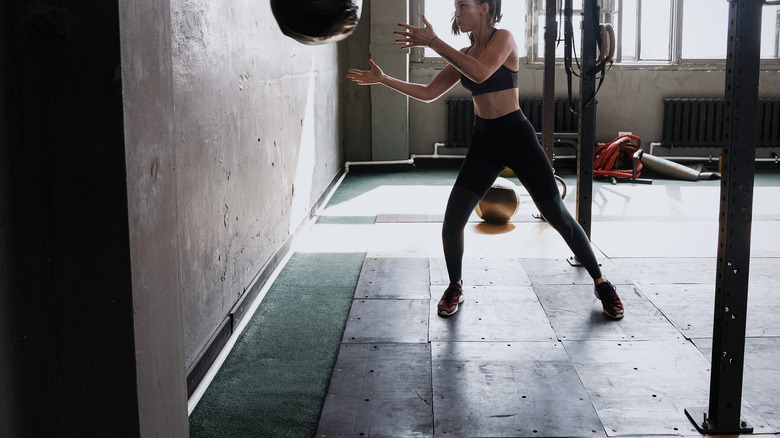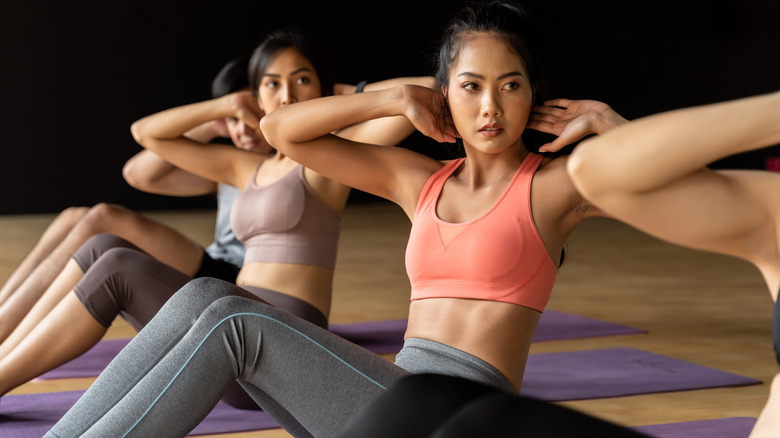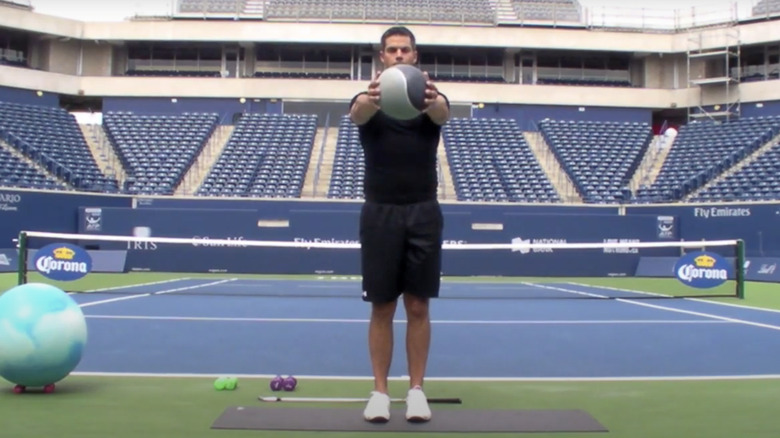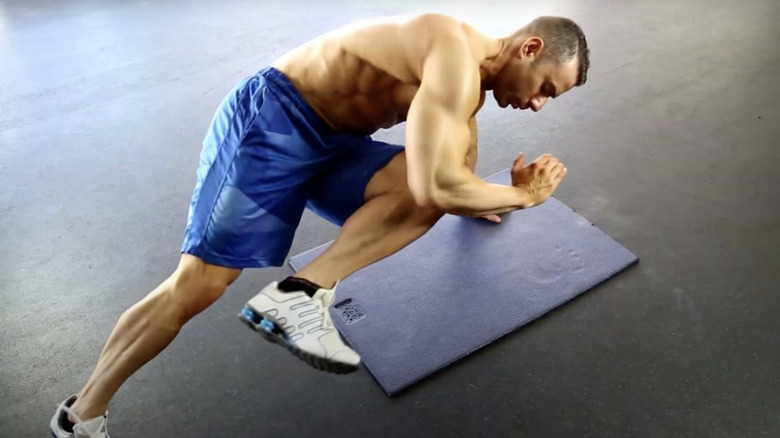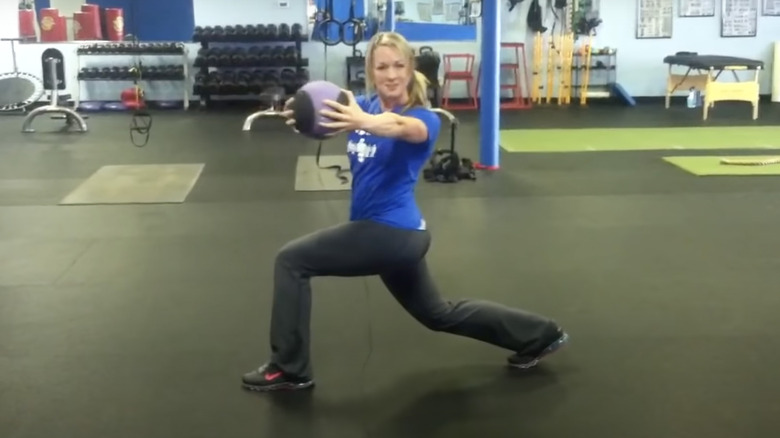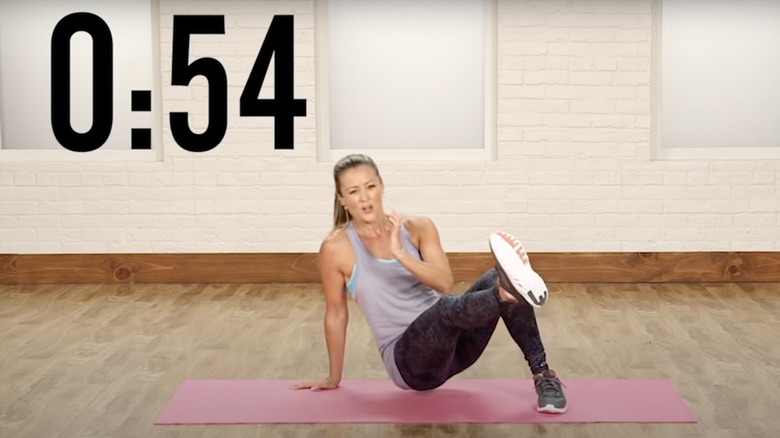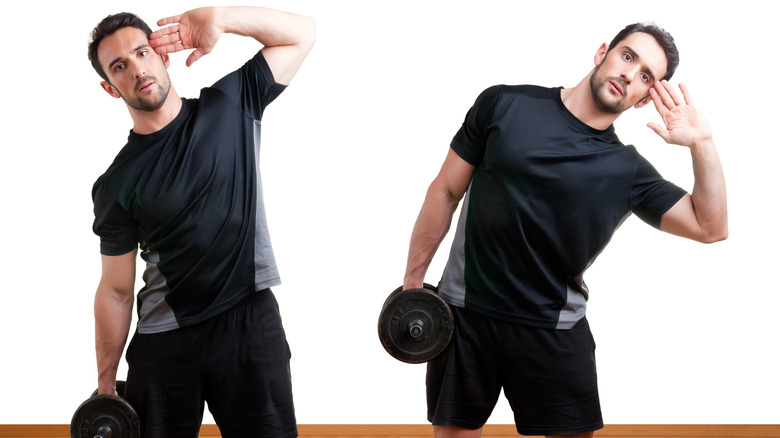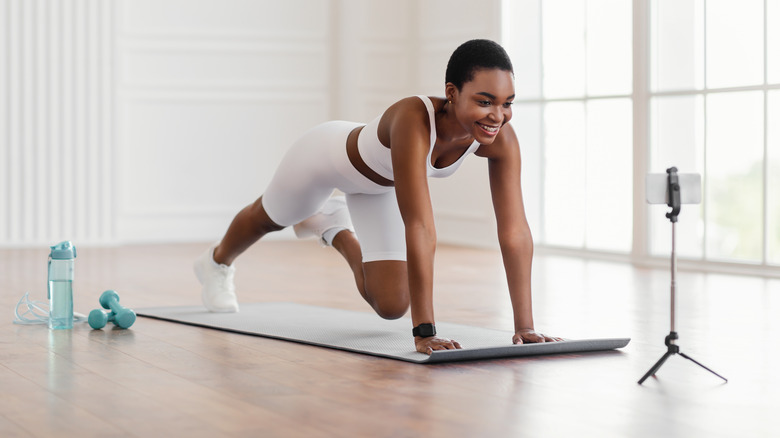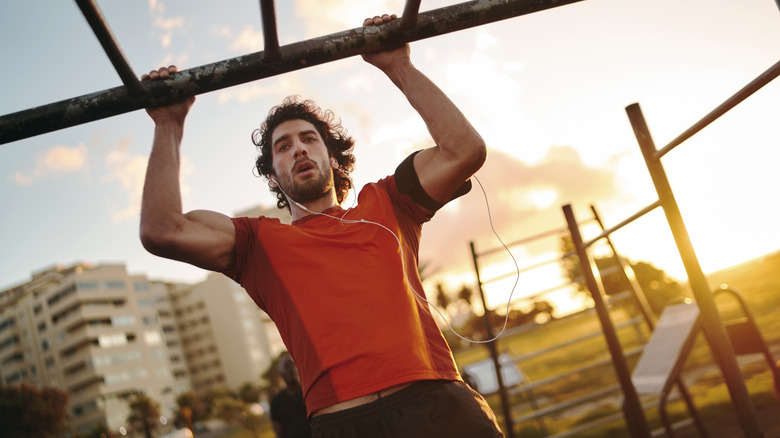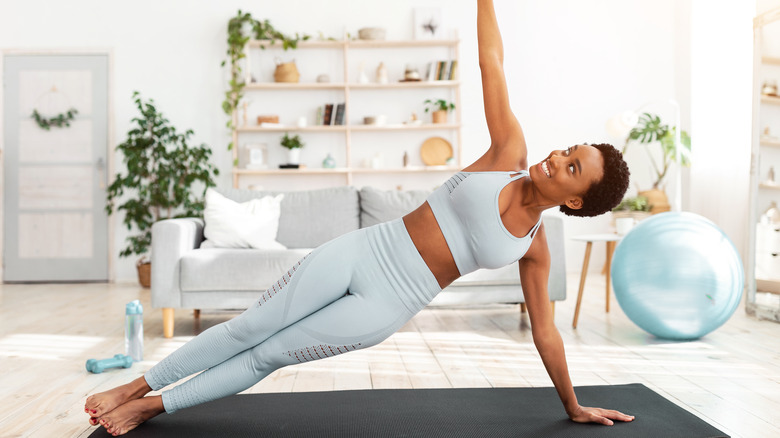The Best Oblique Exercises To Sculpt Your Core
It all starts in the core, folks. Developing and maintaining strength in your core is essential for a range of reasons, from better overall balance to improved performance in basically every exercise you'd care to name (per Harvard Health Publishing). But how many of us, when we think of our core, envisage a rippling six pack and toned central abs, and not much besides? We're willing to bet it's a lot of people.
While doing endless crunches, it can be easy to forget about your obliques. Running along each side of your core, your oblique muscles "are important to support the body and they help to force exhaled air out of the lungs," says pregnancy and postpartum corrective exercise specialist and physical therapist Hillary O'Connor via Live Science. Not only that, but they play a vital role in rotating and bending your torso, both to the sides and forward, and stabilizing the rest of your body, promoting better posture and preventing aches and injuries. But how, in a world of exercises that focus on the abs, do we engage our obliques to work out our core? Well, friends, we've got all the exercises you need right here.
Spiderman plank
If you've ever wished that you could be in a superhero movie, just for a day (and let's be real, most of us have), the Spiderman plank could be for you. While it won't imbue you with Spidey-sense and web-shooting capability, what it will deliver is a serious core workout, activating your obliques and abs, and engaging your upper body too (per Beachbody on Demand and Spotebi). And stronger obliques are essential for when you're swinging through cityscapes trying to catch criminals, so we're told.
To do a Spiderman plank, move into a low plank position, with your upper body resting on your elbows, hands clasped in front of you, and your body in a straight line from your feet to the tip of your head. Engage your core, and as you breathe out, lift one of your feet off the floor and bring your knee toward the elbow on the same side, with your knee moving up the outer length of your body. Ensure that your pelvis doesn't sag while you do so. Squeeze at the top, and then return your foot to its original position while breathing in. Repeat the movement with the other leg for a full rep. Try to do between 10-15 reps before resting.
Bicycle crunch
If you've ever worked your core before, odds are that you've done a bicycle crunch. But while you may have done this exercise due to its benefits to your abs, you may be pleased to know that it's actually incredible for your obliques as well, in addition to activating your deeper abdominal muscles (per The Gym Group).
Grab yourself an exercise mat and lie down on it on your back, with your legs bent and your feet flat on the ground. Raise your head, shoulders, and chest slightly to engage your abs, and then put your hands on the back of your head, keeping your elbows wide. Try to avoid clasping your hands together, as this can encourage you to pull your head up as you're doing the exercise, which you want to avoid. Next, lift one of your legs and bring it in toward your body, with your other leg shooting out straight at the same time. Simultaneously, crunch your abs in and bring the opposing elbow up and toward the bent leg. Take it slow at the beginning: You want to focus on form. Straighten your bent leg as you bring the other leg in, and bring your other elbow in to meet it. Your legs should feel slightly as though you're pedaling a bicycle — hence the name.
Offset dumbbell squat
When we're trying to target our abs, we tend to resort to hauling ourselves onto our backs, crunching and squeezing as though our lives depend on it. But it's useful to remember that exercises that predominantly target another part of the body can be adapted to heighten activation through the abs, and especially the obliques. This is the case with an offset dumbbell squat, which uses a sole dumbbell on each side of the body to heighten the load through your side body, says certified strength and conditioning specialist BJ Gaddour to Men's Health. "As the weight pulls you to the side, your opposite obliques have to fight to keep your torso upright," Gaddour states. Additionally, this move works your legs, biceps, shoulders, and grip too.
Stand with your feet wider than shoulder-width apart and hold a dumbbell in one hand. Shift the dumbbell so that it rests on your shoulder, with your arm tucked into your side. Extend your other arm out for balance, and squat down, sending your hips out behind you. Hold at the bottom, and then push up through your heels. Keep your core activated throughout the exercise.
Side plank
When it comes to oblique exercises, few are more targeted or more effective than a side plank. "Side planks are all about strengthening the side body and stabilizing your spine," states Club Pilates master trainer and certified strength and conditioning specialist Cara Bonney to Women's Health. This additional strength and stabilization keeps your body more equipped to do both everyday tasks and more hardcore workout moves, and keeps injuries at bay.
To begin, lie on one side on an exercise mat and place your forearm flat on the floor in front of you, at a 90-degree angle to your body. Your upper arm can rest on your upward-facing side, and your feet can either be placed upon one another or in a line, both resting on the floor. Push your body up off the floor, activating your core while you do so. Your body should remain straight in this position, not sagging down toward the ground or arching. Hold the side plank for up to 30 seconds, extending the time you hold it as you get stronger through your core. For an added challenge, extend your free arm toward the ceiling.
Medicine ball rotational throw
We like to think of ourselves as calm people, but honestly, how good does it feel to just throw something once in a while? That's exactly what you'll be able to achieve with a medicine ball rotational throw, a standing ab exercise that targets your obliques and abs using a twisting motion (per Bodybuilding).
Your upper body and hips will also be engaged during the exercise, for which you'll need a medicine ball and a sturdy wall. Stand parallel to a wall, a couple feet away from it, with the medicine ball held in front of you in both hands and your feet facing forward. Turn your body away from the wall, keeping your feet planted. Then, with explosive movement, twist your body from your core toward the wall. Release the medicine ball, throw it at the wall, and then catch it as it bounces back to you. Then, repeat. The medicine ball rotational throw can be adapted to your needs: If you're more interested in building additional muscle, use a heavier ball and do fewer reps. If you want to boost your heart rate, however, amp up the reps and use a slightly lighter weight.
Sit-ups to twist
Just because you're focusing on your obliques while you work out doesn't mean that you have to start doing a load of complicated, newfangled exercises. Some of the best oblique exercises take moves we know and just mix them up slightly. The sit-up to twist adds a rotation at the top of the sit-up, and "targets the obliques but you will also work all of the abdominal muscles," says NASM-certified personal trainer Danielle Burrell to Self.
Grab your exercise mat and lie on your back with your feet planted on the floor — though you should avoid bringing them too close to your butt. Put your fingers gently behind each side of your head and then activate your abs while you come into a sit-up position, ensuring that your upper body becomes fully upright at the top. Once your body is at its highest point, rotate your torso to one side, with the elbow of your arm coming almost to meet the opposing knee. Return your body to the center and lower back to the starting position. Repeat the sit-up, this time twisting to the other side, and alternate for your desired amount of reps.
Standing trunk rotation
Rotating movements are excellent for working out our obliques, thanks to their ability to activate our core muscles from a different angle and reach the smaller muscles through our center (per Well+Good). And luckily, they're also super simple to do. Standing trunk rotations are one of the easiest twisting workout moves and activate both our external and internal obliques, with our upper body and arms also feeling the burn, thanks to the weight you hold throughout the exercise (per WebMD).
Stand up straight, with your spine elongated, your feet at hip-width, and a medicine ball held lightly in front of you, just in front of your chest, says ACE Fitness. Ensure that your shoulders are relaxed and back, and keep your core engaged. Then, while breathing out, rotate your upper body to the left. Keep your body in a vertical line as much as possible while you do this, avoiding bending it one way or another. Once you've turned as far as you can go, hold the position for a second, and then rotate back to the center before going the other way. If you want to make this move even harder, you can hold the ball further out in front of you, which will activate your core even more.
Bear crunch
Some obliques exercises are variations on movements you'll know well, but some really amp it up a notch. The bear crunch is one of these exercises. This move might take a little mastery, but trust us when we say that you'll get out what you put in, and your oblique muscles will thank you for it.
Begin by moving onto your hands and knees on an exercise mat, with your upper arms and legs directly placed underneath your joints, as Men's Health advises. Curl your toes under, and while you engage your core, lift your knees up off the ground. Don't straighten your legs as you do this: They should remain bent and hover just a little away from the floor. Lift one of your feet and the opposite arm off the ground, and bring your loose knee under your stabilizing leg and upward to meet the opposing elbow, allowing your body to twist outward as you do so. Make sure that the other hand and foot are well-planted on the floor. Return your body to the starting position, and then repeat the bear crunch on the other side.
Forward lunge with rotation
One of the things we love most about working out our obliques is that we can often do so during exercises that don't seem to target them at all. But with simple adjustments, classic moves like the lunge can become oblique torchers while remaining highly effective for other parts of your body. "Not only does this exercise work the obliques, but it's also a great burn for your shoulders, other areas of the core, and quads, hamstrings, and glutes," states NASM-certified personal trainer Danielle Burrell to Self. We are 100% here for that kind of efficiency.
The caveat, though, is that you'll need a medicine ball to do this exercise (although another type of weight, like a kettlebell, would maybe do the trick too). Stand upright with your back straight and your core engaged, holding the ball in front of you with your arms fully extended. Take a big step forward and move down into a lunge. As you start to reach the bottom of the lunge, twist your upper body in the direction of your bent leg. Make sure that your body doesn't move off-kilter, and your arms don't bend in. Once your body's twisted as far as it will go, return it to the center, and push back up to standing. Repeat with the other leg, switching between the two until you've completed your desired number of reps.
Breakdancer kick
Have you ever marveled at the speed and agility with which breakdancers move through their routine? Of course you have — it's incredible. And we're willing to bet that those breakdancers all have pretty amazing obliques, thanks to one move in their repertoire that doubles as a serious workout exercise: the breakdancer kick. The breakdancer kick doesn't just work your core, but also hits your shoulders, arms, and legs for a workout move with maximum efficiency and maximum fun (per Spotebi).
Start the exercise by moving into tabletop position on all fours position on a mat, and then elevate your knees slightly off the floor, keeping your body static. Lift one of your feet off the ground, with the opposing hand also coming up, and then move your knee under your body and through to the other side. Once your leg is through, kick your foot out and up. Your body should have rotated so that your torso is now facing the ceiling, with your raised hand bent slightly in front of your body. Bring your body back to the starting position and do the same with the other leg. Engagement and form are crucial here — this is a pretty challenging move, so take it slow and perfect it before you pick up the pace.
Dumbbell side bend
Although it's entirely possible to work your obliques using bodyweight exercises, now and again you might need a little extra help. That's where the dumbbell side bend comes in. Using a deceptively simple movement, the dumbbell side bend targets your obliques incredibly effectively while also activating your full abdominals, says Bodybuilding.
Begin in a standing position, with your feet planted a regular width apart and a dumbbell in one hand. Make sure that you're not bending your body forward or back: It should remain upright, with a long spine. Bend your body away from the hand in which you're holding the dumbbell, as far as you can. Then returning to the center, breathing out as you do so. Pause briefly, and then bend in the direction of the dumbbell, allowing it to lower toward the ground. Again, hold the position at the bottom, and then return to the center. Repeat this, alternating sides, for as many reps as you require before switching the weight over to the other hand and doing the exercise again on the other side. If you wish, it's also possible to perform the dumbbell side bend while sitting on an exercise bench.
Cross-body mountain climbers
We've all had that feeling of dread midway through an exercise video when the instructor announces that we're going to be doing mountain climbers next. Yep. It's time to feel the burn. But while they may not be your favorite move, there's no denying that cross-body mountain climbers in particular are very, very good for working your obliques, according to Muscle & Fitness. Additionally, this move works your full abdominal area, hips, chest, triceps, and shoulders, and if done at speed will also raise your heart rate through the roof. Still feeling unsure about doing them?
You'll begin by moving into a high plank with your arms stacked straight under your shoulders. Make sure that your body doesn't sag, that your back is flat, and that your core is engaged, remaining so throughout the move. Lift one of your legs and bring your knee into your body and across it, until it almost touches your opposing elbow. Your hips will want to arch as you do this: Don't let them! Move your leg back and plant it on the floor, and then repeat on the other side. Doing this move slowly and with control will work your muscles more effectively, whereas doing it quickly will turn it into a cardio exercise (per KCRG).
Hanging oblique raise
If you haven't incorporated hanging exercises into your workouts, you really should. Engaging the body from a different perspective, hanging workout moves like pull-ups activate and build muscle using natural body weight, and the hanging oblique raise could be just what your core needs. "Hanging oblique knee raises work to build the abs from the hanging position, improves grip strength and scapular stability, and targets the obliques [the side of your abs] instead of the rectus [the front of your abs]," states trainer to the stars (Sebastian Stan and the Ryan Reynolds, no less) Don Saladino to Men's Health. And all you need is a pull-up bar and your good self.
Stand under your bar and grip it in an overhand position. Lift your body from the ground, and as you do so, twist your body to one side, raising your knees to come up along the side of your body, engaging your obliques. Squeeze slightly at the top, and then return your feet to their starting position before doing the same move on the opposite side. That's a full rep. Try to do four sets before resting, either at the start or the end of your workout.
Side plank dips
We're gonna be honest here, folks: While we love a side plank to blast our obliques, there's no denying that they can be a little boring. And that's where the side plank dip comes in. Adding in a relatively small movement during a side plank can activate your obliques even more — and not only that, but your glutes, inner thighs, lats, and shoulders also feel the burn, according to Bustle. "In addition, side plank dips improve your balance, and they're a fantastic postural exercise that lengthens your muscles," adds Pilates instructor and Frame Fitness co-founder Melissa Bentivoglio.
To do a side plank dip, you'll naturally want to get into a side plank first. Lie on a mat on one side and then shift your body into a side plank, with your feet planted on the ground, your forearm resting on the floor, and your body straight from foot to head. Then, gently dip your hips toward the ground until you almost make contact with the floor, before pulling your body back up to a straight position again. Complete around 10 reps before switching sides. Ensure that when your body comes back up to the side plank, you don't arch or introduce tension through your neck: You want to keep everything relaxed, yet controlled.

